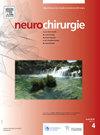Outcomes of Stereotactic Radiosurgery for Jugular Foramen Schwannomas: A Systematic Review and Meta-Analysis
IF 1.4
4区 医学
Q4 CLINICAL NEUROLOGY
引用次数: 0
Abstract
Background
Jugular foramen schwannomas (JFS) are infrequent cranial nerve (CN) lesions accounting for up to 4% of intracranial schwannomas. The management of the JFS is challenging due to its proximity to critical neurovascular structures. Stereotactic radiosurgery (SRS) has emerged as a minimally invasive alternative to resection; however, the available data regarding the outcomes of SRS in JFS is limited. This study aims to evaluate the role of SRS in JFS.
Methods
A systematic search of PubMed, Embase, Scopus, and Web of Science was performed following PRISMA guidelines. Pooled estimates for local control (LC), cranial nerve (CN) deterioration, progression-free survival (PFS), and adverse radiation effects (ARE) were calculated using the R program.
Results
Seventeen studies with 529 patients were included. The pooled LC rate was 94% (95% CI: 91%–96%), with a CN deterioration rate of 9% (95% CI: 3%–16%). The pooled 1-year PFS rate was 98% (95% CI: 96%–100%), 3-year PFS rate was 95% (95% CI: 92–97%, 5-year PFS rate was 92% (95% CI: 88–95%), and 10-year PFS rate was 84% (95% CI: 76–90%). The pooled ARE rate was 6% (95% CI: 2–11%).
Conclusion
SRS results in promising LC and PFS rates along with low CN deterioration and ARE rates in JFS patients. Surgery remains the primary choice for those with larger lesions or mass-related symptoms, while SRS can be the first-line option for small to medium-sized lesions.
立体定向放射治疗颈静脉孔神经鞘瘤的疗效:系统回顾和荟萃分析。
背景:颈静脉孔神经鞘瘤(JFS)是一种少见的脑神经病变,占颅内神经鞘瘤的4%。由于靠近关键的神经血管结构,JFS的管理具有挑战性。立体定向放射外科(SRS)已成为切除的微创替代方案;然而,关于JFS中SRS结果的可用数据是有限的。本研究旨在评价SRS在JFS中的作用。方法:按照PRISMA指南系统检索PubMed、Embase、Scopus和Web of Science。使用R程序计算局部控制(LC)、颅神经(CN)恶化、无进展生存(PFS)和不良辐射效应(ARE)的汇总估计。结果:纳入17项研究,529例患者。合并LC率为94% (95% CI: 91%-96%), CN恶化率为9% (95% CI: 3%-16%)。合并1年PFS率为98% (95% CI: 96%-100%), 3年PFS率为95% (95% CI: 92-97%), 5年PFS率为92% (95% CI: 88-95%), 10年PFS率为84% (95% CI: 76-90%)。合并ARE率为6% (95% CI: 2-11%)。结论:SRS在JFS患者中具有良好的LC和PFS率以及较低的CN恶化和ARE率。对于较大的病变或肿块相关症状,手术仍然是首选,而对于中小型病变,SRS可能是一线选择。
本文章由计算机程序翻译,如有差异,请以英文原文为准。
求助全文
约1分钟内获得全文
求助全文
来源期刊

Neurochirurgie
医学-临床神经学
CiteScore
2.70
自引率
6.20%
发文量
100
审稿时长
29 days
期刊介绍:
Neurochirurgie publishes articles on treatment, teaching and research, neurosurgery training and the professional aspects of our discipline, and also the history and progress of neurosurgery. It focuses on pathologies of the head, spine and central and peripheral nervous systems and their vascularization. All aspects of the specialty are dealt with: trauma, tumor, degenerative disease, infection, vascular pathology, and radiosurgery, and pediatrics. Transversal studies are also welcome: neuroanatomy, neurophysiology, neurology, neuropediatrics, psychiatry, neuropsychology, physical medicine and neurologic rehabilitation, neuro-anesthesia, neurologic intensive care, neuroradiology, functional exploration, neuropathology, neuro-ophthalmology, otoneurology, maxillofacial surgery, neuro-endocrinology and spine surgery. Technical and methodological aspects are also taken onboard: diagnostic and therapeutic techniques, methods for assessing results, epidemiology, surgical, interventional and radiological techniques, simulations and pathophysiological hypotheses, and educational tools. The editorial board may refuse submissions that fail to meet the journal''s aims and scope; such studies will not be peer-reviewed, and the editor in chief will promptly inform the corresponding author, so as not to delay submission to a more suitable journal.
With a view to attracting an international audience of both readers and writers, Neurochirurgie especially welcomes articles in English, and gives priority to original studies. Other kinds of article - reviews, case reports, technical notes and meta-analyses - are equally published.
Every year, a special edition is dedicated to the topic selected by the French Society of Neurosurgery for its annual report.
 求助内容:
求助内容: 应助结果提醒方式:
应助结果提醒方式:


